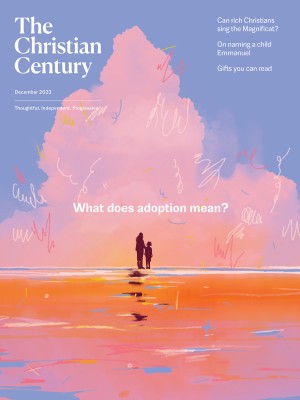December 24, Advent 4B (Luke 1:26–38)
The traditional annunciation story bothers me even more than the word handmaid.
Sometime last year, I sat at a table outside a McDonald’s on the main square of Kraków, Poland. Suddenly the clock struck noon and a cacophony of church bells erupted. Birds scattered. Locals rushed from their daily lives into one of the several clanging churches on the square to pray the Angelus, a short prayer remembering the annunciation: “The angel of the Lord announced unto Mary, and she conceived by the Holy Spirit. . . . Behold, the handmaid of the Lord: be it unto me according to your word. . . . The word became flesh, and dwelt among us.”
“Behold, the handmaid of the Lord” clangs uncomfortably in my contemporary ears. After having spent five seasons with The Handmaid’s Tale, I am disturbed by this depiction of Mary. In Margaret Atwood’s theocratic dystopia, handmaids are women held hostage for their capacity to bear children. The all-male government controls their every move, stripping them of their former lives, names, and agency. For me, the word handmaid brings up notions of women controlled by men exerting power in God’s name. The Me Too movement has clarified and concretized our collective awareness that the nuances of agency and consent must govern questions about our reproductive lives. Otherwise, we stray closer to Atwood’s dystopia.
Read our latest issue or browse back issues.
In Nazareth today, two separate holy sites commemorate the annunciation. Often when there are two sites associated with the same story in the Holy Land, they are competing sites: two different communities claim their stretch of land as the place where a given story really happened.
For the annunciation, though, this is not the case. One site is near an ancient well, and the other is just down the hill in the traditional location of Mary’s house. That’s because some traditions tell the story this way: the first time the angel Gabriel appears to Mary is while she is gathering water at a well. When he starts his announcement with “Greetings, favored woman,” Mary is so startled that she runs all the way home. Despite what holiday cards and Christmas pageants may have entrenched in our collective memory, Gabriel was probably not an Italian painting’s angel with great hair; nor was he garbed in a floppy surplice and crooked pipe-cleaner halo. I would be startled, too.
What’s more, some versions of the story say that the angel follows her. The angel Gabriel follows her to her house, eventually making it all the way through his announcement, at which time Mary agrees to be the mother of God.
This story bothers me even more than the word handmaid. The power imbalance between God himself and a newly engaged young woman in the small town of Nazareth already scared me. Now here’s an image of Mary running home, pursued by an angel.
I’ve kept praying the Angelus through my discomfort. I learned that many still remember the annunciation in Latin: Angelus Domini nuntiavit Mariae, et concepit de Spiritu Sancto. . . . Ecce ancilla Domini. Fiat mihi secundum verbum tuum. . . . Et Verbum caro factum est, et habitavit in nobis.
Repeating the prayer over and over, I slowly recognized that fiat is “be it” or “let it be.” In English, the word fiat conjures an image of a powerful plutocrat willing others into action with bribery or threat. But the fiat in the second versicle of the Angelus refers to Mary’s will, not God’s. Let it be, she says. In the Vulgate, fiat is the same word used to describe God’s creative act in Genesis 1: Dixitque Deus fiat lux. God said, “Let there be light.” Et facta est lux. And light was made. In the moment of the annunciation, Mary is the one in control. She says, “Let it be to me according to your word,” and Jesus is conceived.
In Greek, too, the two passages use the same word, but with a slight difference: Mary uses a type of verb used for wishes and prayers. “Let it be,” she asks of God.
Mary is not the grammatical object of God’s command, like the light. Mary is the subject of Jesus’ conception, with God willing a miracle into being by her enthusiastic response to God’s call. God’s creation of the universe is the ultimate act of divine agency, and likewise Mary’s consent to bear the Son of God is the pinnacle of human agency.
On the days when I believe the story of Gabriel’s pursuit of Mary from the well to her house, I now hold an image of God as giving her another decision point and another chance for informed consent: “Do not be afraid. . . . Nothing will be impossible with God.” God will not make her choose this path. But God will make it possible. Mary is no handmaid of any man but the cocreator with God of Jesus’ very humanity. In this way, the Word became flesh and dwelt among us. Thanks be to God.






